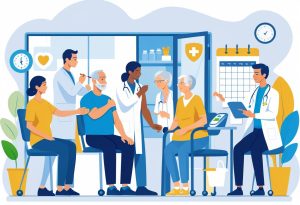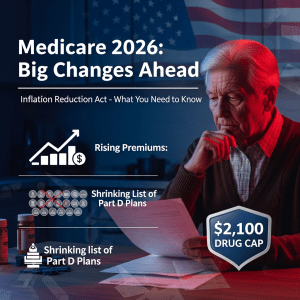COPD is a an inflammation of the small airways(bronchioles) and tiny air sacs in the lungs. This causes narrowing of the airways and destruction of the air sacs making it difficult to exhale air out of the lungs. People complain of shortness of breath, chronic cough with mucus and wheezing. COPD is caused by long term exposure to irritating gases or particulate matter, most often from cigarette smoke. People with COPD are at greater risk of developing heart disease, lung cancer, and respiratory infections.
The two conditions that contribute most to COPD are chronic bronchitis and emphysema. Chronic bronchitis is an inflammation of the lining of the bronchioles. Most people will also have daily mucus production with chronic cough.
Emphysema is when the tiny air sacs (alveoli) at the end of the smallest airways are destroyed as a result of cigarette smoking.
Symptoms include shortness of breath, wheezing, chest tightness, chronic cough that produces mucus, blueness of the lips and fingertips(cyanosis), frequent respiratory infections, lack of energy, unintended weight loss(later in the disease), and swelling of ankles, feet and legs. At times, people with COPD may have an exacerbation- this is when the stable symptoms get markedly worse, most often due a respiratory infection. This requires medication and even hospitalization if severe.
Causes of COPD in the developed world center around cigarette smoking. In poorer parts of the world, COPD is most often caused by exposure to the fumes from burning poor quality fuel for cooking and heating in poorly ventilated homes. Between 20% and 30% of smokers will develop clinically apparent COPD. Other smokers will have some degree of
COPD, but it does not affect their daily lives.
The two large tubes that divide from the trachea are called bronchi. From these, many divisions occur leading to smaller and smaller tubes that end in clusters of tiny air sacs(alveoli).Think of how a tree divides into ever-smaller branches to visualize the tubes of the lung.The air sacs have blood capillaries in their walls and pick up oxygen and release carbon dioxide. The tubes and air sacs need to be elastic to allow this exchange of gases to take place. Emphysema causes them to lose their elasticity and overexpand causing air to be trapped during exhaling. This air-trapping doesn’t allow as much air to be inhaled because part of the air sacs are full of old air. The smallest airways also tend to collapse trapping even more air. If the cause isn’t stopped(smoking), eventually the person will not get enough oxygen into their bloodstream. Chronic bronchitis causes inflammation and narrowing of the small airways(bronchioles) causing obstruction to airflow. Increased mucus production causes further blockage to air, causing the chronic cough to try to clear it out.
There is one genetic cause of COPD. 1% of patients with COPD have alpha 1-antitrypsin protein deficiency. This protein is made in the liver and protects the lungs. It is most common in children and young adults.
The major risk factors for COPD are smoking, smoking with asthma, occupational exposure to certain irritants or gases, age, and genetics.
Complications of COPD most seriously affect the lungs. There is an increased risk of contracting respiratory tract infections. In the event that these patients get the flu or pneumonia, they must seek treatment immediately and may have serious breathing difficulty. Other complications include lung cancer, heart disease, and high blood pressure in arteries that supply the lungs.
The main diagnostic tool are pulmonary function tests. These tests show how the lungs are functioning. Spirometry consists of showing how much air the lungs can hold and how fast they can blow it out. This gives valuable information that can guide treatment.
The mainstay of treatment is to quit smoking. Medication that reduces inflammation can be administered by hand-held inhalers. Other inhaled medications help open narrowed airways. Inhaled steroids are very effective at reducing inflammation and don’t cause the same type of complications that oral steroids do. Some patients require extra oxygen to function and others can need a lung transplant
I hope this has given the readers an introduction to COPD and any questions will be gladly answered.
Keith M. Oshan, M.D.

What Services Are Free Under Medicare Preventive Care: Essential Benefits Explained
Medicare preventive services are designed to maintain your health and detect issues early.





